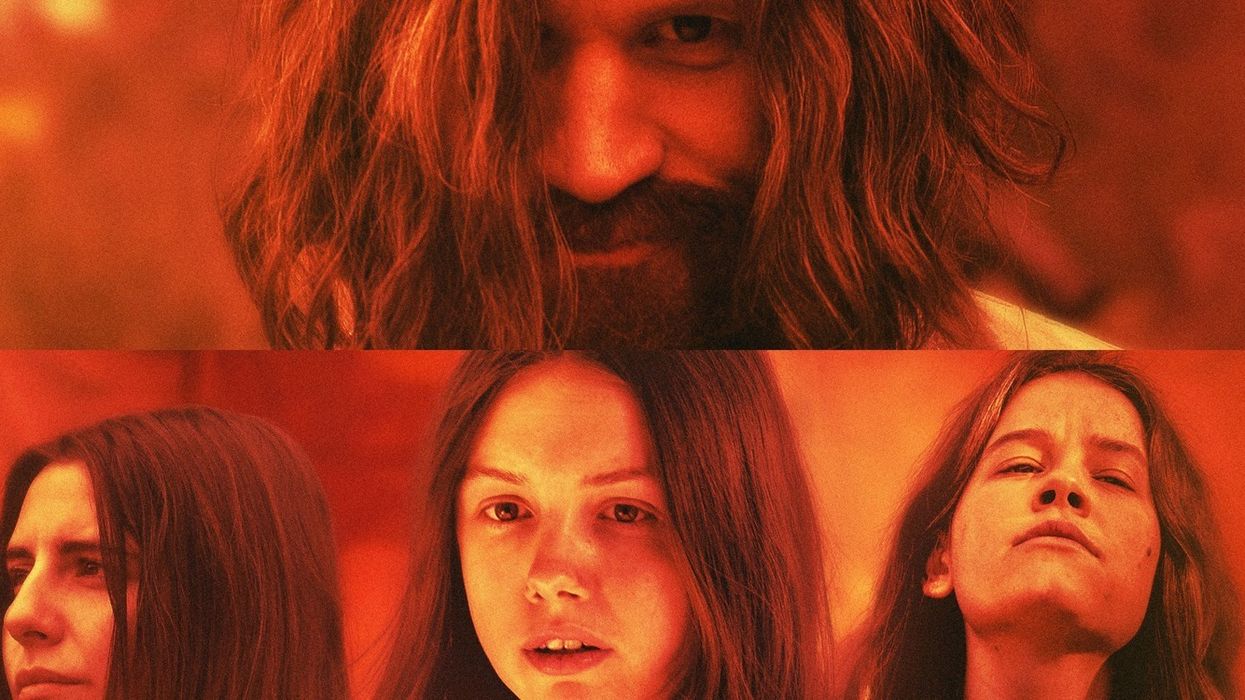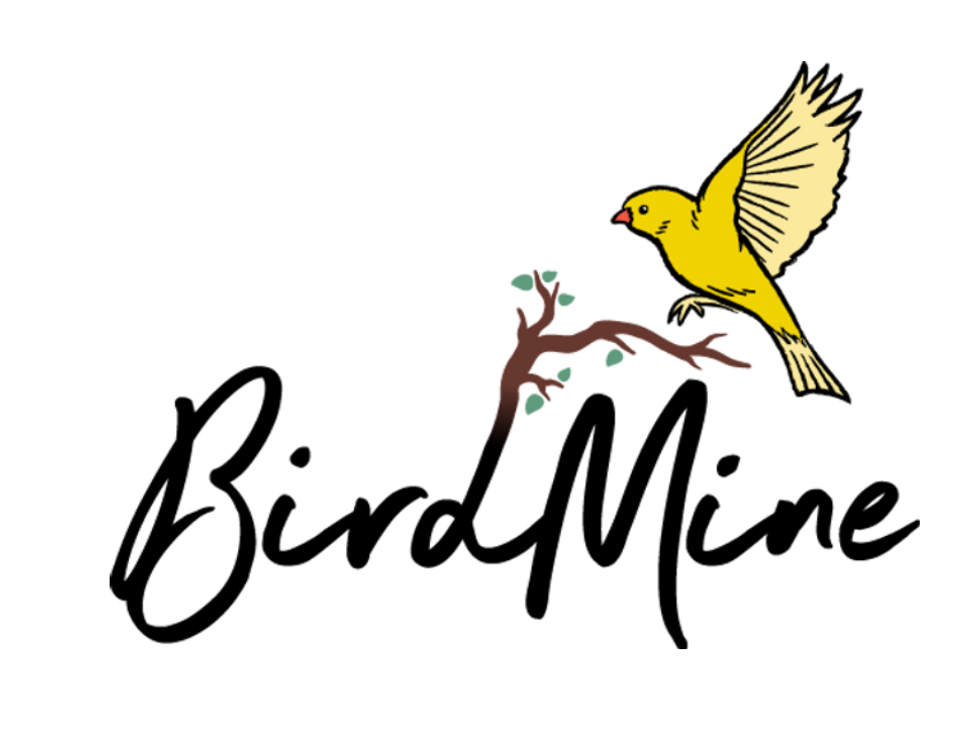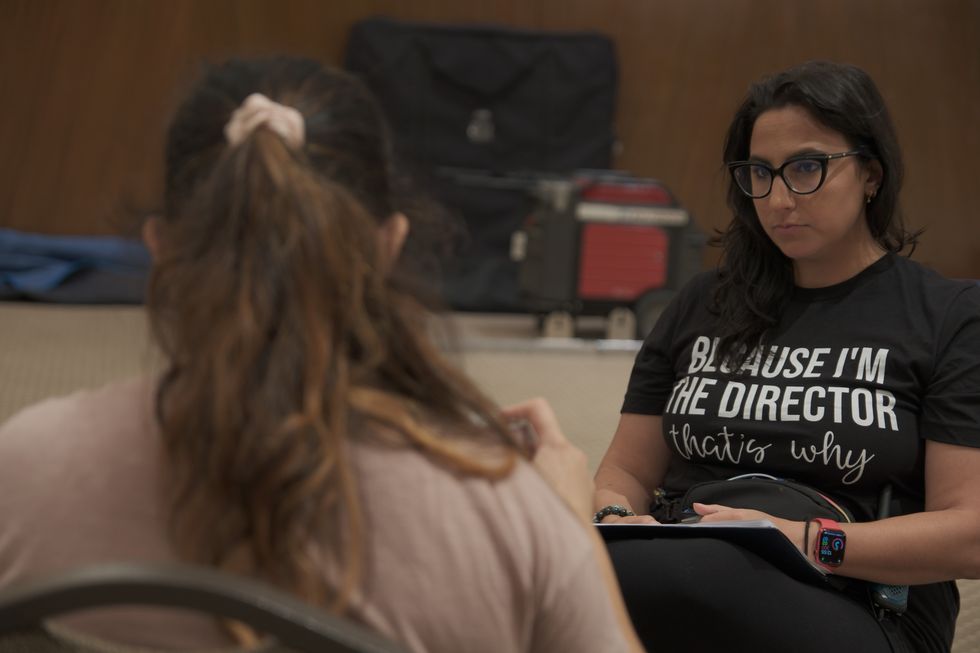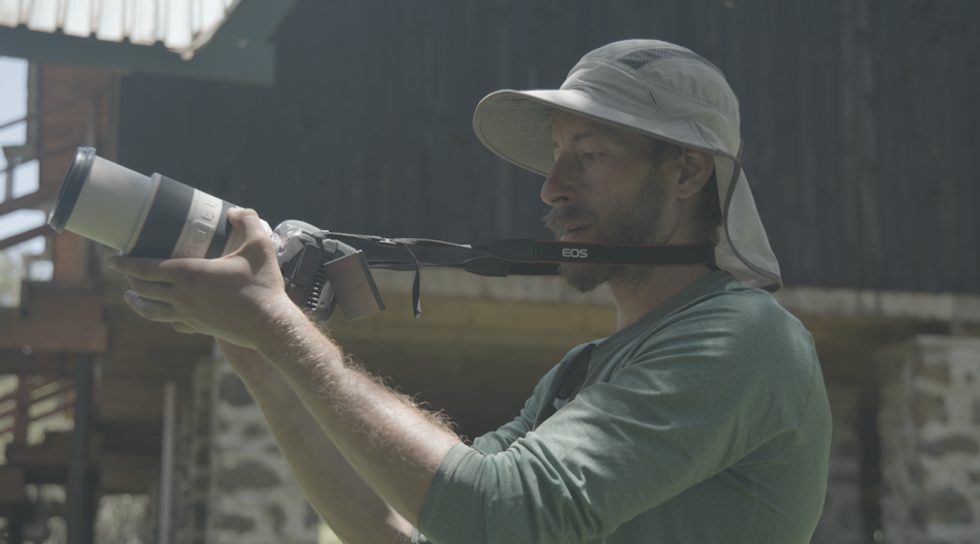How Growing Up in a Cult Helped Tell The Story of a Real 'American Psycho'
'Charlie Says' stars Hannah Murray as a woman who comes under the influence of Charles Manson.

The new Charles Manson movie isn't really about Charles Manson. Charlie Says is concerned, rather, with the women who came under Manson's spell—the women who would ultimately participate in what came to be known as the event that killed the '60s.
What drove these pretty young women to murder Sharon Tate and six other people in the Los Angeles hills on that horrific night in 1969?
It's a question that no one knows the answer to, save for one graduate student, Karlene Faith, who tried to help the women from the confines of their prison cells. What she found when she dug deep into the convicted murderers' psyches was a disturbing network of groupthink and undying adulation for Manson. That, and remnants of decayed individual identities.
Director Mary Harron and screenwriter Guinevere Turner cut back and forth between the infamous Manson family ranch and the women's prison in the psychologically compelling drama, which stars Hannah Murray (Game of Thrones) as Manson family member Leslie Van Houten, who was found guilty of the murders along with Susan Atkins (Marianne Rendón) and Patricia Krenwinkel (Sosie Bacon). Manson (Matt Smith) is portrayed as a carefully manipulative leader who preys on female insecurity by building the young women up and then tearing them down. The film does dramatize the murders, but its most interesting scenes are quotidian—moments where it's possible to see how Manson wormed his way into the women's' subjectivity, little by little, until questioning him became an act of betrayal to their own selves.
"I grew up in a cult. I don't know any other screenwriters who grew up in a cult. This was exciting for me because I could bring something to the material that no one else can." — Turner
No Film School sat down with Turner and Harron—who also wrote and directed American Psycho, respectively—to discuss how Turner used her own experience in a cult to inform the screenplay, why Harron prefers TV miniseries to feature directing, and so much more.
Guinevere Turner, Screenwriter
No Film School: I just read your New Yorker article, My Childhood in a Cult. Wow. What a life story. Was that planned in advance of the film?
Guinevere Turner: I've wanted to write about my upbringing for a long time, but I haven't. I guess the obvious reasons being obviously I'm saying stuff that people won't want to have public. But then I was talking with Mary when we were shooting Charlie Says and I was like, "Oh, god, anyone who Googles me for more than a little bit is going to see that I grew up this way and they're going to want to talk about it's like it's relevant now." People always do that whenever I have a movie come out, and I just deflect. But now it's relevant. I was dreading it. And so Mary said, "Why don't you write a piece yourself and see if you can get it out there?" The idea was when I'm actually doing press for the movie, I can sort of point to it and say, "That's what I have to say about that."
"A screenplay is a description of a thing that is likely to never exist. You better be okay with that." — Turner
NFS: You say your upbringing is relevant now in regards to the film. Was your experience in cults what attracted you to write Charlie Says?
Turner: Well, the producers wanted to meet me [originally]. They wanted to make a movie that focused on the women in the Manson story. They met with me, I guess, 'cause of American Psycho—"that edgy lady screenwriter." And then I was like, "Guess what? I'm pretty much the only person in the world who should write this movie. I grew up in a cult. I don't know any other screenwriters who [grew up in a cult]." This was exciting for me because I could bring something to [the material] that no one else can.
I never wanted to make a movie about my life. Turning my childhood into a movie just feels tacky. I will write a book. So this was perfect. I could actually put my childhood to use in a way that feels non-exploitive and in service of something else that isn't about me. That was exciting.
I wrote it and gave it to Mary to read for notes and she was like, "Oh, this is the best thing you've ever written."
NFS: Do you two work really well together? What is it about your working relationship that works so well?
Turner: First of all, we share a sensibility. We share a sense of humor. We laugh a lot when we're writing, even if it's dark stuff. We find weird things funny—dark things.
Almost instantly after we met, we decided to write something together. We almost instantly had the same affinity that we have now. I think part of it is trust and a lack of ego. You know, when you're trying to work with someone, sometimes you don't trust if they're challenging your ideas because they want it to be their idea. We never feel like that with each other. We have this built-in trust that we both want [the movie] to be the best thing it can be. And luckily we usually think that's the same thing. We also are really good at talking each other into and out of things without thinking that there's a hidden agenda.
I feel super lucky because I've also tried to write and collaborate with other people, to varying degrees of success. But this one's really working.

Turner: That was the word I've been looking for all day—authenticity. Yeah. People can imagine what situations like this are like, but it's only going to be voyeuristic in a sense.
NFS: What did you bring to the script that you felt might not have been obvious to somebody who would have tried to think about a cult voyeuristically?
Turner: Something that I wrote about in my essay is bringing in the mundane. There's no way you can sustain a level of, like, "it's all an acid trip or an orgy" to a cult story. At the end of the day, you do have to cook food and just sit around and eat dinner. I wanted to ground it in the daily operations of a family.
Then, also, [I incorporated] the way things can be really beautiful and magical and then all of a sudden not be—this volatile nature of [being in a cult]. The uncertainty. All of a sudden something's going to completely change. It's one way, and then it's another. That happens a bunch of times in the movie—just even in conversations, and on a bigger scale. That is 100% drawn from my own upbringing.
"I teach screenwriting and I've never studied screenwriting." — Turner
NFS: That was fascinating to me. I think it's really difficult to bring the audience along for the ride for those tonal shifts. When you're writing them, how do you think about putting those to the page?
Turner: Before I even started writing, I knew that I wanted to have little micro-moments that sort of prepare us for the big one. Once [Charles Manson] doesn't get his record contract, everything's just weird and dark—literally, too, on the screen. But also emotionally and for the characters.
I don't know. I've never studied screenwriting. I teach screenwriting and I've never studied screenwriting. I teach screenwriting at the graduate level and I've never gone to grad school. I'm very proud of that for some reason.
When I think about answering that question, I think so much of what I do is instinct. So it's hard to explain. It's so intangible. There is not really a method. There's a method after I've written the first draft, but when I write the first draft, I'm just like, "Go with it. Get in that zone and just do it."
For my first film that I wrote, Go Fish, I had never read a screenplay when I wrote that.
NFS: Seriously?
Turner: Seriously. But, you know, I had seen a billion movies. I've always loved movies since I was a kid. Maybe that's part of it.

Turner: It's hard to explain, but I'll try. I tried to explain it to my students too. Some of them get it and some of them don't.
To me, the hardest thing is to take a deep breath and feel the thing as a whole. What I do is I try to write the entire movie on one page. Every scene. I do that so I can look at one piece of paper and that's the whole movie. When you do that, things start to stand out.
NFS: When you're looking for moments that stand out, what are you looking for and why? What are you going to do with that information?
Turner: [I'm looking for] things that are repetitive—things that are digressive. I usually color-code my script by either character or world. I'm looking at the balance of how much this person is talking, or how long it's been since we've been away from this other person. With the paper, I can feel it all as a whole and then I can feel where the balance is off. I've literally never articulated it this way!
"I hate reading screenplays. It's boring. It's annoying. You have to make the movie in your head." — Turner
NFS: Since you teach screenwriting, I'm wondering: What do you generally advise your students, based on your experience, that might be helpful for them if they want to become a screenwriter?
Turner: I think it's actually something that's true for all things: you have to keep doing it, and you're going to get a million no's. And if you're not the kind of person who is strong enough for no's, then you shouldn't be doing it. Because—and this is the frustrating part—a screenplay is a description of a thing that is likely to never exist. You better be okay with that. It's not like a book. You're writing a description. You've described a thing that doesn't exist—and 95% of the time, it won't exist. Can you live with that for the rest of your life?
I've written, I don't know, probably a hundred scripts that [never got made]. You have to keep writing. You get better at it. And you have to accept the fact that maybe you're just talking to yourself.
If you write an essay, even if no one publishes it, it is the thing. You know what I mean? The screenplay's not the thing. I hate reading screenplays. It's boring. It's annoying. You have to make the movie in your head. I hate that I have to read so many screenplays in my life. It's the most irritating form to read. But that's my life.

No Film School: How long has this project been on your radar and, and why did you decide to do it?
Mary Harron: I think I started working on it in 2014, but not for me--for another director. I thought this would be a very interesting project for [Guinevere] to write, actually. I don't know if you've read her piece in the New Yorker. I always had wanted her to write something about her [own life]. I would say, "Oh, Gwyn, you should write about that." And she was reluctant. Anybody's reluctant to write a personal story. But this is a perfect way for her to use some of that insight and experience and bring it to the story of this cult.
Guinevere told me that she'd found this woman, Carlene Faith, who had the oldest insight into what happened to the [Manson] women in prison. And that was very intriguing to me because I realized I had no idea what happened to the women in prison. I had no idea what happened to them after the trial—almost nobody does. So, it's like, "Oh, well, that's a story that hasn't been told. That's a completely different angle on it."
NFS: Did you collaborate closely with her while she was writing the script?
Harron: I gave notes on it. I was very taken with it. I realized, "Oh, I could [direct this] ... this is up my alley." So, if the other director drops out, I would be interested in doing it.
NFS: And then the director dropped out.
Harron: Yeah!
NFS: When you first read the script, what came to mind in terms of building out the visual world?
Harron: That came later for me, about how to visualize it. I was more concerned with supporting the story.
I think the scene that really grabbed me initially was when Sandy [one of the Manson women] is by the bonfire at night, early on, and [Manson] asks her to take off her clothes. And you think is going to go one way—this sinister sex scene—but then it becomes this strange, almost religious ritual when he shows her scars to the group and gets her to expose herself and says, "You're perfect. You're beautiful, and you always have been." He kneels down, kisses her feet as if she's Jesus. And it has an emotional effect on her and on the people watching. It was a brilliant mixture of something genuinely uplifting, and also, a tremendous amount of manipulation. The complexity of that, contained in that one scene was, to me, what would be interesting about the entire movie.

Harron: There's so much material out there. Initially, obviously, producers always want you to go for famous people. And then when you get that out of the way, you're focusing on who could really capture [Manson] freely. You want someone who could be a very complicated and charismatic figure—who could do a lot of layers, a lot of things going on at once. Manipulative but charismatic, funny and playful sometimes, scary sometimes, sometimes acting a little crazy, like "on the edge," and then violent sometimes. So, you need somebody who could contain a lot of things in one. That was Matt Smith.
We decided not to worry about the fact that he didn't look like Charles Manson. He wore a wig and contact lenses and he developed—which is so important when playing a real person—the walk and the physical movement of Manson's. Matt, himself, almost became a professional soccer player. So, he's very fit and erect. And he does this hunched over, shambling walk for Manson, which seems very natural when you see it. It just seems very Charlie. Also, it had the effect of making him appear a bit smaller. He said, "Make sure my clothes are too big for me. It'll make me seem smaller."
"I had everybody come out to the ranch for two weeks and to just try and be in character as the Manson family." —Harron
NFS: What about cultivating the relationships between the Manson girls? What did you do in rehearsal to work on their performances?
Harron: We definitely had a couple of weeks of rehearsal time, which was good. So, they got to know each other. Right before filming, I had everybody come out to the ranch for two weeks and to just try and be in character as the Manson family. They did some singing and played guitars and it was very nice. It was funny because Matt couldn't come, and it turned out to be a good thing. He was always a bit separate because he was the leader and they needed to bond together as the family.
NFS: Going into production, were there any challenging situations you didn't necessarily expect?
Harron: Yes. Torrential rain in the California desert for days. The scene where they're performing for Terry Melcher—it was pouring rain half that day. We had tarps over the cameras and everyone had to run for shelter and then we'd come back. And it's raining, actually, in some of those takes, but you don't necessarily see it.
We had a wonderful line producer, David Hillary. I have to give him a shout out. He was just fantastic and really kept this project going. I could not have made it without him. And we talked a lot about the logistics—the fact that we only had 20 days. That was very difficult. Certain things made it possible. One was a fast crew. That's one thing benefit to shooting in Los Angeles. You get people on top of the game.

NFS: What about the 20-day production schedule? I can imagine you had to make some concessions here and there. How do you prioritize?
Harron: Well, I think you don't have a lot of fancy shots. You don't have a lot of cranes because they take too much time. You do a lot of handheld. You can't work with somebody who's going to do very elaborate lighting, or who won't let you change the blocking because it's going to affect their lighting.
I had a great DP, Crille Forsberg, a Swedish cinematographer who has done a lot of commercials. He had also done these famous music videos. He'd done David Bowie's "Lazarus" video, and he did Bruno Mars's "Uptown Funk," and these videos for Robin, the Swedish singer.
When I talked to him about the fact that Matt Smith wants to improvise a lot, he said, "That's fine because I'm used to it." He was good at capturing action. That meant we could do a lot of handheld on the ranch and he could follow the action.
"We had four people sitting in a circle. It's what we call the Quadrangle of Death. It's the hell of eye lines!" —Harron
NFS: What was your aesthetic approach to the cinematography?
Harron: I wanted to create a late '60s look, early '70s. We loved the look of Badlands, and we use that as a model. [Crille] did this thing where he wanted it to look like film. So, he did something called Viracon, where you flash the film with a certain color. It affects the color range. We had that attached to the camera.
We shot on the RED, which I normally am resistant to use because I've always thought, "Oh, that looks very digital," but we used the 7K Monstro. Crille wanted it because the color timing was very important to get that '60s look. There's some skin tone that he wanted that I think we got.
NFS: Also, there's a lot of low-light situations in the film. So, I'm sure you wanted that digital latitude.
Harron: Yeah. We wanted a raw aesthetic—a rougher look. So, if it goes dark, it goes dark. Which I liked. On the ranch, we shoot with a lot of natural light, but maybe boosted the windows a bit.
The ranch stuff went very quickly. It was harder, actually, to shoot the very static stuff in the prison because we had to just shoot a lot of different angles. And because we were actually shooting on a stage—a set of a prison. For it to look real, you actually needed to do some pretty careful lighting.
NFS: Sometimes the things that look the simplest and the easiest are the hardest to shoot!
Harron: Yeah. I thought, "Oh, the prison. Fine. Nobody's moving. They're just sitting in a room." But actually, it's four people sitting in a circle. It's what we call the Quadrangle of Death. It's the hell of eye lines! If you're really going to get the eye lines right in close-ups, you're doing the scene 10 times. It's much harder than doing an orgy on the ranch where you just do three or four roving takes.

Harron: Yeah, I love Hannah. She is such a truthful and emotionally transparent actor. Everything on her face shows and you gain so much of the story just through her close-ups. I think that she's very instinctive. Before she got [to set], when I was in pre-production, we had some long Skype calls where we just went through the script and talked through all the scenes. I think that was a big help. And then she did her own research. That's all I really do: I talk scenes with [actors] individually, go through the script from page one or whatever their first scene is, so they get a sense of their storyline and make sure that we see the character the same way. Then I'll do some rehearsals for a few days before shooting.
NFS: Did anything challenging come up during the editing process?
Harron: Oh, there's always the surprising of scenes that you think, "Oh, I love this," and then it [gets cut] in the first pass because it just takes away from the narrative.
Actually, there were several early Sharon Tate scenes that we cut. It never really worked even on the page—the story cut back and forth between the Manson ranch to Sharon Tate living her life. Every time we went in [to Sharon's life], it's jarring. We needed to take them out. I said, "We'll make a little TV documentary out of it." And that's what [one of the characters] is watching on television in the movie. It really worked. Initially, we were just going to use some documentary footage, but I said, "No, let's use the footage that we shot."
NFS: I thought the music really captured the era. How did you navigate that process?
Harron: We had a very limited budget for the music, but we managed to find this less famous psychedelia that really seemed to work for the film. It's a group called Love, a great '60s group. Then a group called the 13th Floor Elevators, another called Blue Cheer, and some others. And then my editor had this collection of obscure psychedelia. He found this Swedish group from the '60s and a great track called "International Harvester." We used for the big orgy scene.
NFS: Do you prefer working in movies or television? You've shot a lot of both.
Harron: It depends on how much control you get. I did a miniseries for Netflix called Alias Grace. I had a lot of control over that because I was able to be very involved in the casting, and see it all the way through because I directed all the episodes. So, that was more like doing a very long movie.
I like doing television. I've learned a lot from it. It's boot camp. And it's not yours. You have to keep within the style and all that. But doing a miniseries is the best of both worlds because you have more money to work with, frankly, and then you have some autonomy.
The cliche is true: television is more of a writer's medium. Certainly, you can't do a good TV show if the script isn't good. That's also true of movies, but it's even more true of television.

 BirdMine
BirdMine Allison Norlian and Kody LeibowitzBirdMine
Allison Norlian and Kody LeibowitzBirdMine Allison NorlianBirdMine
Allison NorlianBirdMine Kody LeibowitzBirdMine
Kody LeibowitzBirdMine









